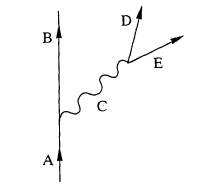
March
1999
1.
(a) (i)
State two
differences between a proton and a positron.
(ii) A
narrow beam of protons and positrons travelling at the same speed enters a
uniform magnetic field. The path of the positrons through the field is shown in
figure 1.
Sketch
on figure 1 the path you would expect the protons to take.

(iii)
Explain why protons take a different path to that of the positrons.
(5)
(c) A positron with kinetic energy 2.2 MeV and an
electron at rest annihilate each other.
Calculate the
average energy of each of the two gamma photons produced as a result of this
annihilation.
(2)
7 (i) Name two hadrons.
(ii) Name two leptons which are also antiparticles.
(iii) State a possible quark structure of the pion po.
A
table of the properties of quarks is given in the Data booklet.
(iv) A K- kaon is a strange particle.
State
one characteristic of a strange particle.
(4)
June 1998
7
(a) K+ has a strangeness +1 and K- has a strangeness -1.
State
which of the following processes are allowed and which are not allowed.
Give
a reason for those not allowed.
|
|
|
|
|
|
|
|
(6)
(b) (i)
State one property, other than lepton number, that is different for a
neutrino and an antineutrino.
(ii)
Name a particle for which the particle and antiparticle are identical.
(iii)
A negative muon, m-, decays into an
electron and two neutrinos.
Complete the decay equation for the negative muon.
![]()
(3)
(c) The
three figures below are Feynman diagrams, each showing two protons interacting
through different fundamental interactions.

(i) What fundamental interaction is
represented by each figure?
(ii)
Explain why the interaction shown in figure C is the least likely to be
observed.
(4)
March
1998
6. (a) (i) Write down the
quark composition of the following.
baryon
antibaryon
meson
(ii)
The kaons K+ and KO both have a strangeness of +1.
Write down the quark composition of these kaons.
(5)
(b)
(i) The kaon K' may
decay to a muon, pion and a neutrino.
Complete, in full,
the decay equation.
![]()
(ii) What fundamental interaction is responsible for the decay of the
kaon K'?
(3)
(c)
Calculate the total kinetic energy, in MeV, of the particles created from
the K+
if the
kinetic energy of the K' was 110.500MeV when it decayed.
(3)
June
1997
2 A
beta particle is emitted from an unstable nucleus when a neutron in the nucleus
changes into a proton.
(a)
(i) Complete the equation below which represents this process.
![]()
(ii) State which particles in the
process are baryons and which particles are leptons.
(iii)
What fundamental interaction or force has been involved in this process?
(5)
(b) (i) Describe the process given in part (a) in terms of
changes in the quark composition of the baryons involved.
(ii)
The Feynman diagram for this process is shown below.
Identify each
of the fundamental particles represented in the diagram.
(5)

June 1995
4
The figure shows tracks produced in a bubble chamber when an electron and
a positron are created simultaneously in a uniform magnetic field directed into
the diagram.

(i) Explain why the tracks curve in opposite
directions.
(ii) Explain why each track spirals inwards.
(iii)
Which track, X or Y, is created by the positron?
(5)
5
(a) (i) State the quark
composition of the proton.
(ii) State the charge,
baryon number and strangeness of the proton. Refer to the data booklet if
necessary.
(iii) The
![]() meson
has a charge of 1 and strangeness of 0. State its composition in terms of quarks
and antiquarks.
meson
has a charge of 1 and strangeness of 0. State its composition in terms of quarks
and antiquarks.
(3)
(b)
In B+ decay, a proton changes into a neutron because one type
of quark in the proton changes into a different type of quark. The Feynman
diagram for this process is shown below.

(i)
What type of quark is represented at A?
(ii)
What type of quark is represented at B?
(iii)
What particles are represented at C, D and E respectively?
(iv)
Which of the particles A, B, C, D and E are leptons?
(6)
6(a) The strong nuclear force, the weak nuclear force and the electromagnetic force are three different types of force.
(i) Which one of these three forces is due to the exchange of virtual photons between charged particles?
(ii)
Why are the photons referred to as virtual?
(iii) What
property of the exchange, or mediating, particle is responsible for the infinite
range of the electromagnetic force?
(3)
(b) The three forces listed above are all
present in an unstable beta‑emitting nucleus.
(i)
For each of these three forces, state whether or not its presence makes
this nucleus more or less stable.
strong nuclear
weak nuclear force
electromagnetic force
(ii)
A positron is emitted from a nucleus when a proton changes to a neutron
in the nucleus.
The Feynman diagram for this process is shown.

Identify
the particles labelled A, B, C and D in the diagram.
(iii) Name an exchange particle of the weak nuclear
force.
(iv) State
one difference between the photon and the exchange particle of the weak nuclear
force.
(7)